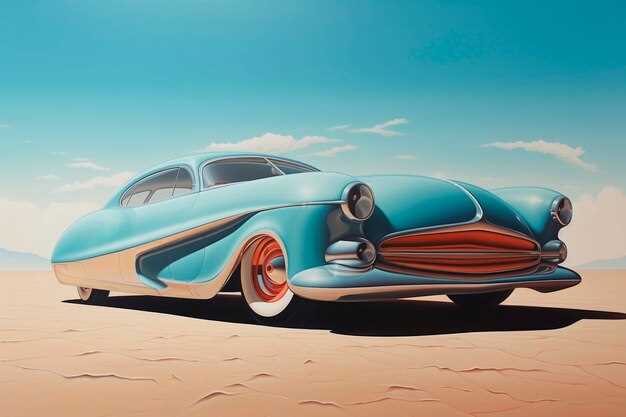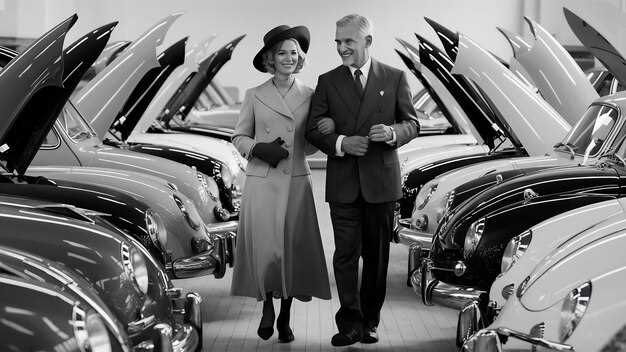
The 1970s marked a transformative decade in the automotive industry, characterized by a blend of innovation, creativity, and a response to changing societal values. American car designers during this period faced unique challenges, including rising fuel prices and increased safety regulations, which necessitated a shift in design philosophy. Their ability to adapt and redefine automotive aesthetics not only influenced the vehicles of the time but also left a lasting impact on future generations of designers.
Among the notable figures of this era, designers like Bill Mitchell and Larry Shinoda stood out for their visionary contributions to American muscle and performance cars. Their work embodied the spirit of the 1970s, blending powerful engineering with striking designs that resonated with consumers. The decade saw a resurgence of creativity, as designers sought to create cars that not only performed well but also conveyed a sense of identity and style.
As we explore the influential designers of the 1970s, it is essential to recognize how their work reflected the cultural shifts of the time. The focus on fuel efficiency and environmental awareness gradually began to take precedence over raw power, prompting a new wave of designs that balanced aesthetics with practicality. This article delves into the lives and contributions of these remarkable designers, highlighting their pivotal roles in shaping the American automotive landscape.
Key Innovations and Trends in 1970s Automotive Design

The 1970s marked a transformative era in automotive design, characterized by a blend of innovative technology and evolving consumer preferences. One significant trend was the shift towards more aerodynamic shapes, which aimed to improve fuel efficiency during a time when gas prices surged and the oil crisis loomed large. Designers began to prioritize streamlined forms and reduced wind resistance, setting the stage for future generations of vehicles.
Another notable innovation was the introduction of safety features, spurred by increasing public concern over road safety. The implementation of crumple zones, energy-absorbing steering columns, and seatbelt reminders became more common, reflecting a growing emphasis on occupant protection. This shift not only enhanced vehicle safety but also established a legacy of design that prioritized human factors in engineering.
The 1970s also saw advancements in materials, with a move towards lighter-weight components and increased use of plastics. This not only improved fuel economy but allowed for more creative design possibilities. The expansion of color options and interior customization transformed the consumer experience, as manufacturers recognized the value of personal expression through vehicle aesthetics.
The emergence of the “pony car” culture significantly influenced design trends. Models like the Ford Mustang and Chevrolet Camaro showcased aggressive styling and performance-oriented features, capturing the imagination of a generation. These vehicles emphasized power and flair, leaving a lasting legacy on the sport coupe segment.
Lastly, the implementation of stricter emissions regulations prompted designers to integrate cleaner technologies into their vehicles. This led to the exploration of alternatives, including electric and hybrid vehicles, foreshadowing the future of the automotive industry. The environmental consciousness that began in the 1970s continues to resonate today, as the legacy of this era shapes modern automotive innovation.
Influential Designers and Their Signature Models
The 1970s marked a dynamic era in the American automotive industry, driven by a wave of innovative designers who shaped the aesthetics and performance of vehicles. Among these influential designers, a few stand out for their unique contributions and iconic models.
One of the most notable figures was Paul Bracq, who was instrumental in designing the classic Chevrolet Corvette Stingray. Bracq’s vision for the Stingray showcased sleek lines, a sweeping profile, and a powerful stance, elevating the Corvette to a symbol of American muscle. His work not only contributed to the model’s legacy but also influenced other sports car designs during the decade.
Another significant designer from this period was Larry Shinoda, who is often credited with the design of the legendary Pontiac Firebird Trans Am. The Trans Am’s aggressive styling, characterized by bold graphics and a pronounced front end, captured the essence of the muscle car craze of the late 1970s. Shinoda’s ability to blend functionality with eye-catching aesthetics made the Trans Am a favorite among enthusiasts.
Additionally, the work of Bill Mitchell, the chief designer at General Motors, cannot be overlooked. Mitchell’s influence spanned multiple decades, yet his contributions during the 1970s included the design of the Buick Riviera. The Riviera was recognized for its elegant curves and distinctive rear design, showcasing Mitchell’s knack for luxury and sophistication in automotive design.
Finally, Richard Teague left a lasting impact with his work on the AMC Javelin. Teague emphasized performance while ensuring that the Javelin stood out with its distinctive styling and sporty appearance. His innovative approach helped define the personal luxury coupe segment during a time when the market was evolving rapidly.
These designers, along with their signature models, played a crucial role in defining the character of American cars during the 1970s. Their legacies continue to influence contemporary design and remain celebrated among automotive enthusiasts today.
The Lasting Influence of 1970s Car Designs on Modern Vehicles

The 1970s was a pivotal decade for automotive design, marked by a diverse range of styles and innovations. Designers during this era, such as Marcello Gandini and Bill Mitchell, introduced bold lines, unique silhouettes, and vibrant colors that set the stage for future generations of vehicles.
One of the most significant contributions from the 1970s is the shift towards more expressive and aerodynamic shapes. This trend can be seen in modern cars, where aerodynamics plays a crucial role in both aesthetics and fuel efficiency. The influence of iconic shapes like the Chevrolet Corvette and the DeLorean DMC-12 are evident in current models, showcasing a blend of style and performance that resonates with today’s consumers.
Additionally, the era’s experimentation with materials and manufacturing processes laid the groundwork for advancements in modern automotive production. Designers of the 1970s began utilizing lightweight materials, which are now standard in the industry, enhancing fuel efficiency and overall vehicle performance.
Furthermore, the emphasis on personal expression and customization in the 1970s has evolved into today’s wide array of options for consumers. Modern vehicles often offer extensive customization programs, allowing buyers to tailor their cars in terms of color, trim, and technology, reflecting the legacy of individualistic design from that decade.
In terms of interior design, the 1970s saw a rise in comfort and technological integration, trends that continue to influence current vehicle interiors. The focus on driver-centric layouts and the incorporation of advanced audio systems and ergonomic seating are direct descendants of the innovations brought forth by designers of that time.
Overall, the bold visions and groundbreaking ideas from the 1970s have not only shaped the vehicles of today but have also established a framework for future innovation in car design. The decade’s influence remains a testament to the enduring legacy of its designers.











